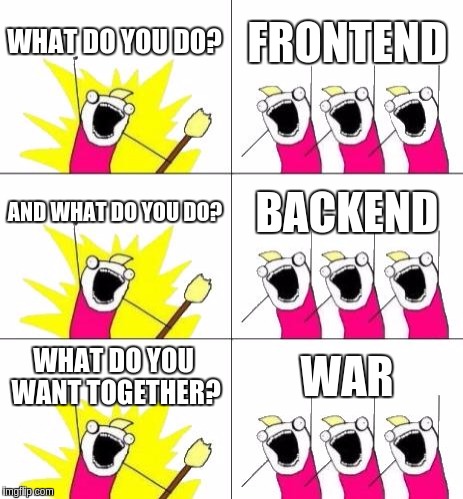A few weeks ago Google published Angular 2.0 final release. I’ve already tried it and I like it. However, if you
face with some problem, it probably will be difficult to find solution in the internet. Angular2 has been strongly changed
since rc1 was published. That’s why there are a lot of outdated information. I think we must fix this problem and
publish a lot of articles and posts about angular2. My contribution is article about building the application with
angular2 client.

Build requirements
I used to have following features in client build system:
- Dependency management
- Build for development with debugging and proxy
- Build for production (compressed)
- Check style
- Unit tests
- E2E tests
Possible implementations
Angular2 tutorial recommends us to use npm as a dependency manager. As I know, Bower is officially not supported, but there are some ways to use it. In short, now the package manager is npm without alternatives.
Firstly I tried to use gulp to write build script. I’ve almost done it, but the system was too complicated. For example, I remember that using bower with custom gulp build script I had to write simple string ‘bower install smth –save’ to add a dependency. I couldn’t achieve the same usability for my custom gulp system due the fact that I’m responsible not only for adding it, but also for compiling typescript to javascript.
Then I found Angular-CLI project. It has all features I want. It also gives an interface for easy creating angular2 applications. For example, this command generates ready component even with unit test.
ng g component my-new-component
However, to add a dependency I have to write it in two places: package.json and angular-cli.json file. I don’t like it, anyway it is standard and a newer won’t have problems with it.
Angular-CLI is also google’s project. I expect it will be supported and it will have a huge community. So you won’t stay with a problem alone. My choice is definitely angular-cli.
Integration with maven
I have a multi-module maven application. It has a few server modules and one client module. So, the structure is like this:
app
app-client
dist
src
proxy-config.json (will be added)
...
pom.xml
app-webapp
pom.xml
...
pom.xml
I skipped some files and modules that are not mentioned in this article. The client application has been created with angular-cli (using ng new). Starting from this state step by step I’ll show my build system.
Add proxy
I used to launch the server at port 8080, but client serves at 4200 port. So I need to proxy some requests from 4200 to 8080 port. To do it with angular-cli just add proxy config file (proxy-config.json) in client’s root.
{
"/api": {
"target": "http://localhost:8080",
"secure": false
}
}
To enable proxy just add option –proxy-config proxy-config.json to serve command.
Npm scripts
I’m going to use frontend-maven plugin. It downloads node and npm and performs necessary commands. The following modification of scripts part of package.json allows to run all necessary angular-cli commands with npm.
"scripts": {
"start": "ng serve --proxy-config proxy-config.json",
"build": "ng build --dev",
"prod" : "ng build --prod",
"lint": "tslint \"src/**/*.ts\"",
"test": "ng test",
"pree2e": "webdriver-manager update",
"e2e": "protractor"
},
For example, now I need run simple ‘npm run-script start’ for serving the client with proxy.
Run npm tasks from maven
Here is my client’s pom.xml. It has two plugins. First one cleans dist directory where production client build is situated. The second one launches two npm scripts: npm install and npm run-script prod. It is very important don’t forget –prod option in package.json, without it a result build will be not optimized. If you want, you can add more npm scripts with test or check style.
<build>
<plugins>
<plugin>
<artifactId>maven-clean-plugin</artifactId>
<version>2.5</version>
<configuration>
<filesets>
<fileset>
<directory>dist</directory>
<includes>
<include>*</include>
</includes>
</fileset>
</filesets>
</configuration>
</plugin>
<plugin>
<groupId>com.github.eirslett</groupId>
<artifactId>frontend-maven-plugin</artifactId>
<version>${frontend-maven-plugin.version}</version>
<executions>
<execution>
<id>install node and npm</id>
<goals>
<goal>install-node-and-npm</goal>
</goals>
<configuration>
<nodeVersion>${node.version}</nodeVersion>
<npmVersion>${npm.version}</npmVersion>
</configuration>
</execution>
<execution>
<id>npm install</id>
<goals>
<goal>npm</goal>
</goals>
<configuration>
<arguments>install</arguments>
</configuration>
</execution>
<execution>
<id>prod</id>
<goals>
<goal>npm</goal>
</goals>
<configuration>
<arguments>run-script prod</arguments>
</configuration>
<phase>generate-resources</phase>
</execution>
</executions>
</plugin>
</plugins>
</build>
Add optimized production build to war
I use maven-war-plugin to put client to war. It just copies a directory. Here is my pom.xml from app-webapp module. I made this module depending on app-client, to provide that dist directory will be already created when maven-war plugin starts working.
<dependencies>
<dependency>
<groupId>groupId</groupId>
<artifactId>app-client</artifactId>
<version>1.0-SNAPSHOT</version>
</dependency>
</dependencies>
<build>
<plugins>
<plugin>
<groupId>org.apache.maven.plugins</groupId>
<artifactId>maven-war-plugin</artifactId>
<version>2.6</version>
<configuration>
<webResources>
<resource>
<!-- this is relative to the pom.xml directory -->
<directory>../app-client/dist/</directory>
</resource>
</webResources>
</configuration>
</plugin>
</plugins>
</build>
That’s it. Now mvn clean package command builds either server and client sides and packs it into war.
